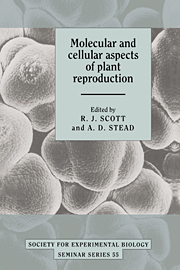Book contents
- Frontmatter
- Contents
- List of Contributors
- Introduction: ‘Where do we go from here?’
- Molecular control of floral organogenesis and plant reproduction in Petunia hybrida
- Control of floral morphogenesis in cauliflower (Brassica oleracea L. var. botrytis): the role of homeotic genes
- Isolation and properties of mutants of Arabidopsis thaliana with reduced sensitivity to short days
- Asexual mutants in Melandrium album (Silene alba): tools in cDNA cloning and analysis of an X/Y chromosome system in plants
- Pollen exine – the sporopollenin enigma and the physics of pattern
- The diversity and regulation of gene expression in the pathway of male gametophyte development
- Characterisation of Arabidopsis thaliana anther-specific gene which shares sequence similarity with β-1,3-glucanases
- Ovule cDNA clones of Petunia hybrida encoding proteins homologous to MAP and shaggy/zeste-white 3 protein kinases
- Towards the elucidation of the mechanisms of pollen tube inhibition during the self-incompatibility response in Papaver rhoeas
- Intracellular movement and pollen physiology: progress and prospects
- Organisation and functions of cell surface molecules on gametes of the brown algae Fucus
- Strategies of flower senescence – a review
- The physiology of petal senescence which is not initiated by ethylene
- Molecular biology of flower senescence in carnation
- Ethylene sensitivity and flower senescence
- Ethylene biosynthetic genes and inter-organ signalling during flower senescence
- Index
Asexual mutants in Melandrium album (Silene alba): tools in cDNA cloning and analysis of an X/Y chromosome system in plants
Published online by Cambridge University Press: 04 August 2010
- Frontmatter
- Contents
- List of Contributors
- Introduction: ‘Where do we go from here?’
- Molecular control of floral organogenesis and plant reproduction in Petunia hybrida
- Control of floral morphogenesis in cauliflower (Brassica oleracea L. var. botrytis): the role of homeotic genes
- Isolation and properties of mutants of Arabidopsis thaliana with reduced sensitivity to short days
- Asexual mutants in Melandrium album (Silene alba): tools in cDNA cloning and analysis of an X/Y chromosome system in plants
- Pollen exine – the sporopollenin enigma and the physics of pattern
- The diversity and regulation of gene expression in the pathway of male gametophyte development
- Characterisation of Arabidopsis thaliana anther-specific gene which shares sequence similarity with β-1,3-glucanases
- Ovule cDNA clones of Petunia hybrida encoding proteins homologous to MAP and shaggy/zeste-white 3 protein kinases
- Towards the elucidation of the mechanisms of pollen tube inhibition during the self-incompatibility response in Papaver rhoeas
- Intracellular movement and pollen physiology: progress and prospects
- Organisation and functions of cell surface molecules on gametes of the brown algae Fucus
- Strategies of flower senescence – a review
- The physiology of petal senescence which is not initiated by ethylene
- Molecular biology of flower senescence in carnation
- Ethylene sensitivity and flower senescence
- Ethylene biosynthetic genes and inter-organ signalling during flower senescence
- Index
Summary
Introduction
Mutants affecting sexual development in plants are relatively rare. Most of them concern cytoplasmic or nuclear male sterility, while a series of meiotic mutants in maize are well characterised (Kaul & Murthy, 1985). Other mutants, of the sex conversion type, have been described in maize and cucumber, two monoecious plants (Irish & Nelson, 1989; Malepszy & Niemerowicz-Szczytt, 1991).
Among flower pattern mutants, those affecting floral organs in whorls 2 and 3 exhibit various degrees of homeotic transformation of stamens into carpels e.g. apetala3 in Arabidopsis thaliana and deficiens in snapdragon (Jack, Brockman & Meyerowitz, 1992; Schwarz-Sommer et al., 1990). The corresponding genes have been cloned and represent transcription factors belonging to the MADS class.
We have recently described two asexual mutants in the dieocious Melandrium album, following irradiation of pollen with low doses of gammarays (Veuskens et al., 1992). Briefly, the mutants 5K63 and 8K40 have normal perianth organs (sepals and petals), while lacking both male and female reproductive organs: vestigial stamens and a ‘finger-like projection’ instead of carpels are present in whorls 3 and 4 respectively. Both mutants have a deletion covering respectively 12 and 21% of the Y-chromosome.
Here we report on the use of these asexual/Y deletion mutants in cDNA subtraction cloning and exploit them in refining the current understanding of sex determination in a plant X/Y system
- Type
- Chapter
- Information
- Molecular and Cellular Aspects of Plant Reproduction , pp. 39 - 48Publisher: Cambridge University PressPrint publication year: 1994



